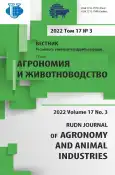Создание исходного селекционного материала клевера лугового с высокими кормовыми качествами для условий Северного региона
- Авторы: Корелина В.А.1, Батакова О.Б.1, Зобнина И.В.1
-
Учреждения:
- Федеральный исследовательский центр комплексного изучения Арктики им. академика Н.П. Лаверова Уральского отделения Российской академии наук
- Выпуск: Том 17, № 3 (2022)
- Страницы: 287-298
- Раздел: Генетика и селекция растений
- URL: https://journal-vniispk.ru/2312-797X/article/view/315627
- DOI: https://doi.org/10.22363/2312-797X-2022-17-3-287-298
- ID: 315627
Цитировать
Полный текст
Аннотация
Клевер луговой - основная многолетняя бобовая культура в Северном регионе. Изложены результаты изучения в конкурсном сортоиспытании (2019 и 2021 гг.) 10 образцов клевера лугового по питательной ценности и кормовой продуктивности. Проведена оценка продуктивности, количества сырого протеина, жира, клетчатки, сахара, зольных элементов, каротина в контрастных метеорологических условиях. Годы исследования по сумме температур, накоплению осадков и гидротермическому коэффициенту имели существенные различия. За период отрастание - начало цветения клевера лугового гидротермический коэффициент (ГТК) составил в 2019 г. 2,2, в 2021 г.- 0,75. Цель исследований - изучение питательной ценности и продуктивности селекционных образцов клевера лугового и отбор перспективных для дальнейшей селекционной работы. Выявлена превалирующая роль погодных условий над сортовыми особенностями образцов. В засушливый 2021 г. изучаемые показатели питательной ценности (кроме фосфора) были выше, чем во влажный 2019 г. По содержанию питательных веществ выделены следующие сортообразцы СД-326, К-17421, К-46524, К-44964, К-1939, достоверно превышающие стандарт или показывающие результат на уровне стандарта по двум и более химическим компонентам. По высокой питательной ценности и сбору протеина в среднем за два года испытаний достоверно подтвердили превышение над стандартом три образца: СД-326-1227 кг/га (+ 130 кг/га), К-17421-1308 кг/га (+ 211 кг/га), К-46524-1156 кг/га (+ 59 кг/га). Полученные результаты будут использованы при создании сортов клевера лугового с высокими питательными свойствами и кормовой продуктивностью.
Ключевые слова
Об авторах
Валентина Александровна Корелина
Федеральный исследовательский центр комплексного изучения Арктики им. академика Н.П. Лаверова Уральского отделения Российской академии наук
Автор, ответственный за переписку.
Email: korelina60@mail.ru
ORCID iD: 0000-0001-6052-7574
кандидат сельскохозяйственных наук, заведующий лабораторией растениеводства
Российская Федерация, 163032, Архангельская обл., Приморский район, п. Луговой, д. 10Ольга Борисовна Батакова
Федеральный исследовательский центр комплексного изучения Арктики им. академика Н.П. Лаверова Уральского отделения Российской академии наук
Email: obb05@bk.ru
ORCID iD: 0000-0002-9883-6054
кандидат сельскохозяйственных наук, старший научный сотрудник лаборатории растениеводства
Российская Федерация, 163032, Архангельская обл., Приморский район, п. Луговой, д. 10Ирина Валентиновна Зобнина
Федеральный исследовательский центр комплексного изучения Арктики им. академика Н.П. Лаверова Уральского отделения Российской академии наук
Email: 4856490@mail.ru
ORCID iD: 0000-0001-8585-0036
научный сотрудник лаборатории растениеводства
Российская Федерация, 163032, Архангельская обл., Приморский район, п. Луговой, д. 10Список литературы
- Kosolapov VM, Shamsutdinov ZS, Piskovatskii YM, Novoselov MY, Tyurin YS. The basic species and varieties of fodder crops: results of scientific activity of the central breeding center. Fodder journal. 2016; (11):29—34. (In Russ.).
- Karakchieva EF. Promising legume-cereal mixtures for arable forage production in the north. Fodder journal. 2015; (9):3—6. (In Russ.).
- Kapustin NI. Problems and prospects of biologization of agriculture in north-west regions. In: Scientific support for the development of the agro-industrial complex in the conditions of reformation. Saint Petersburg: SPbGAU publ.; 2011. p.32—35. (In Russ.).
- Novoselov YK, Shpakov AS, Novoselov MY, Rudoman VV. Role of legumes in perfection of field grass cultivation in Russia. Fodder journal. 2010; (7):19—22.
- Kosolapov VM, Shamsutdinov ZSh, Matveeva OS, Georgiadi NI, eds. Ekologicheskaya selektsiya i semenovodstvo klevera lugovogo [Ecological selection and seed production of meadow clover]. Moscow: Elf IPR publ.; 2012. (In Russ.).
- Sapega VA. Productivity and adaptability parameters of millet varieties cultivated for green forage and seeds. Fodder journal. 2014; (12):27—30. (In Russ.).
- Konstantinova OB, Kondratenko EP. Assessment of productivity and stability of new varieties of winter rye under condition of forest-steppe zone of Kemerovo region. Achievements of science and technology in agroindustrial complex. 2015; 29(3):7—9. (In Russ.).
- Polyakov PV. Fundamentals of natural climatic zones and their impact on the economic assessment of rational nature use. Economy and ecology of territorial formations. 2017; (2):80—85. (In Russ.).
- Prudnikov AD, Rekashus ES. Comparative assessment of productivity of new varieties of clover in agroecological conditions of the Smolensk region. Bulletin of agrarian science. 2011; (4):12—14. (In Russ.).
- Figurin VA, Suntsova NP, Cheglakova OA. Nutritional value and productivity of early varieties of a meadow clover at different regimes of use. Agricultural science of Euro-North-East. 2015; (3):38—42. (In Russ.).
- Kashevarov NI, Saprykin VS, Danilov VP. Multicomponent mixtures for haylage in addressing the shortage of fodder plant protein. Fodder journal. 2013; (1):3—7. (In Russ.).
- Ganushchenko O. Fibre in ruminant diets. Animal Husbandry of Russia. 2019; (10):37—42. (In Russ). doi: 10.25701/ZZR.2019.72.82.010
- Dydykina AL, Nakonechnyy AA, Shalaginova LN. Improving feed quality in the Arkhangelsk region. Fodder journal. 2017; (12):28—30. (In Russ.).
- Tyapugin EA, Simonov GA, Bogatyrev EV, Fomenko PA, Korelskaya LA, Tishchenko AG, et al. Spravochnik khimicheskogo sostava i pitatel’nosti kormov [Handbook of chemical composition and nutrition of feed]. Vologda — Molochnoye: Vologda GMHA publ.; 2016. (In Russ.).
- Sizova YV. Functionally metabolic value of carbohydrates in cow feeding. Bulletin NGIEI. 2013; (4):115—121. (In Russ.).
Дополнительные файлы










